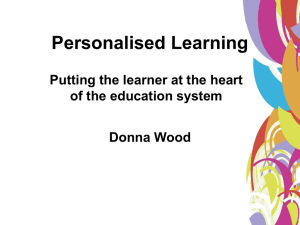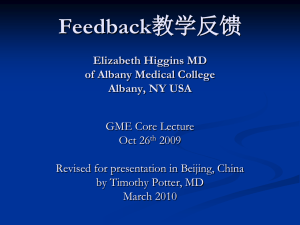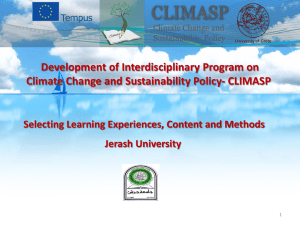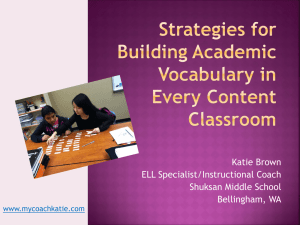Unit 4C - National Union of Teachers
advertisement
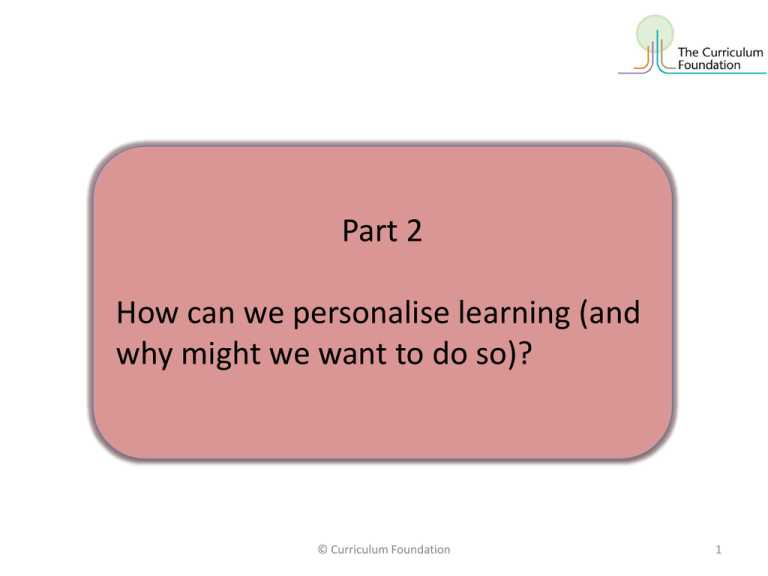
Part 2 How can we personalise learning (and why might we want to do so)? © Curriculum Foundation 1 There are some very different interpretations of the term ‘personalised learning’. One was part of the 2004 “Five Year Strategy”, and the subject of various publications such as: http://www.tlrp.org/documents/personalised_learning.pdf This saw five elements to personalised learning: 1. Assessment for learning 2. Teaching and learning strategies to develop competence 3. Flexible pathways, entitlement and student choice 4. A student-centred approach 5. Strong partnerships These ideas are still influential ten years later. Although effective in many ways, these were not directly about the curriculum (apart from pathways). © Curriculum Foundation 2 Another interpretation of ‘personalised learning’ is to see it as having every pupil working on something different at the same time – a sort of infinite ‘differentiation’. This is not only impractical but is probably counter-productive as well. Some very successful countries strongly oppose the notion of differentiation because they see it as denying entitlement to some pupils. Interestingly, the original notion of personalisation came first from research into effective learning. It is not to do with infinite differentiation at all – or even the five aspects from 2004. Did you recognise the people below when we saw them earlier? © Curriculum Foundation 3 This is David Hargreaves, author of “A New Shape for Schooling?”. You can find it in the link below. http://www.myecoach.com/online/resources/13 729/a_new_shape_for_schooling _11.pdf “When personalisation is well developed, the learner is articulate, autonomous but collaborative, with high meta-cognitive control and the generic skills of learning, gained through engaging educational experiences with enriched opportunities and challenges, and supported by various people, materials and ICT linked to general well-being but crucially focused on learning, in schools whose culture and structures sustain the continuous co-construction of education through shared leadership.” © Curriculum Foundation 4 This introduces the notion of the “co-construction of learning”. In co-construction, students: • • • • Are engaged with learning Take responsibility for their own learning Show independence and have control over learning Enjoy confidence in themselves as learners This is put forward in a model: © Curriculum Foundation 5 Some schools see co-construction as asking pupils what they want to learn about a particular subject aspect or topic. In this way, the teacher and pupil shape the learning between them. For example, the teacher asks, “What do you want to find out about the Romans?” Then some joint planning ensues. This is much more common in primary than in secondary schools. The approach needs clever shaping on the part of the teacher to ensure that there is sufficient challenge and coherence, but it does start the process of co-construction, and does give the learner a stake in their own learning. This approach can often be helpful, but it raises the issue that people (especially young pupils) don’t know what it is they don’t know, so they are not always in the best position to say what it is they need to learn! (Do you remember the former UD Secretary of Defense, Donald Rumsfelt and his “unknown unknowns”?) © Curriculum Foundation 6 Did you recognise the second picture? She has written extensively about (as you might expect) how the brain operates in learning. The connection here is that the brain is always active in learning anyway, as the learner seeks to make sense of new information. The more we can frame learning within the learner’s own context of understanding, the more powerful it will be. Therefore, the more we can involve the learner in the process of co-construction as learning develops, the more likely we are to enable the learner to make sense of the new material. It must make sense in their own terms. Goswami U (2006). Neuroscience and education: from research to practice? Nat Rev Neurosci 7(5):406-11 It’s Professor Usha Goswami, Professor of Cognitive Developmental Neuroscience at St John's College, Cambridge © Curriculum Foundation 7 The ‘design triangle’ approach makes this much easier to achieve, because we are not just trying to plough our way through a set amount of content. We are using the three elements as parameters within which to design learning. There is therefore scope to design the experience in such a way that it meets the present understanding of the learner, and is set within their frame of meaning. This is personalised learning. In a sense, the ‘Assessment for Learning’ aspect of the five elements would do this as well, insofar as this seeks to explore the learner’s present understanding, and then build In this model, the na onal curriculum Programmes of Study (PoS) supply the ‘subject content’. The present Secondary PoS also supply the Key Concepts – but on that. these will disappear in the new na onal curriculum. The Key Skills will come from the skills element of the competencies that you listed in Unit 2. The PoS will, in this model, provide the knowledge context for the competencies. Between these three, the learning experience is defined. Subject content Learning experience Key Concept Key Skill © Curriculum Founda on © Curriculum Foundation 9 8 This does not always have to be individual. There is a difference between ‘personalised’ and ‘individualised’. Learning is a social function, and at its best involves a corporate endeavour. We need to make learning make sense to the group in the first instance and to provide support to individuals where necessary within the group. The personalisation comes from interpreting the national curriculum expectations in terms of key concepts and competency skills and so framing it for a particular set of pupils. So the key question is how to design a learning experience that meets the three criteria and makes sense in terms of our learners’ present set of understandings. In this model, the na onal curriculum Programmes of Study (PoS) supply the ‘subject content’. The present Secondary PoS also supply the Key Concepts – but these will disappear in the new na onal curriculum. The Key Skills will come from the skills element of the competencies that you listed in Unit 2. The PoS will, in this model, provide the knowledge context for the competencies. Between these three, the learning experience is defined. One way of doing that is to locate learning in a local setting. Subject content Learning experience Key Concept Key Skill © Curriculum Founda on © Curriculum Foundation 9 9




